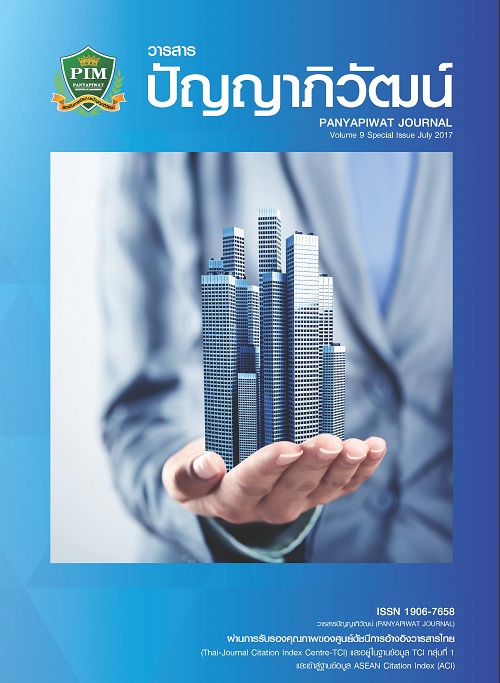สถานการณ์ปัจจุบัน และแนวทางการประกอบธุรกิจภัตตาคาร/ร้านอาหารไทย ประเทศกัมพูชา
Main Article Content
บทคัดย่อ
การวิจัยนี้มีวัตถุประสงค์เพื่อศึกษาสถานการณ์ปัจจุบัน และแนวทางการประกอบธุรกิจภัตตาคาร/ร้านอาหารไทยในประเทศกัมพูชา เป็นการวิจัยเชิงคุณภาพ ใช้วิธีการสุ่มแบบไม่ใช้ความน่าจะเป็น โดยการสุ่มแบบเจาะจง ประชากรคือ ผู้ที่มีส่วนได้ส่วนเสียเกี่ยวกับการประกอบธุรกิจภัตตาคาร/ร้านอาหารไทย/เครื่องปรุงอาหารไทย ในเส้นทางท่องเที่ยวไทย-กัมพูชา (เสียมเรียบ-พนมเปญ) กลุ่มตัวอย่างที่เป็นผู้ให้ข้อมูลสำคัญ ประกอบด้วยผู้ประกอบการภัตตาคาร/ร้านอาหาร จำนวน 12 ราย ผู้ประกอบการทัวร์/ไกด์ 3 ราย เจ้าหน้าที่ภาครัฐ 3 ราย ผู้เชี่ยวชาญอาหารไทย 2 ราย รวมทั้งสิ้น 20 คน เครื่องมือที่เก็บรวบรวมข้อมูลใช้แบบสัมภาษณ์กึ่งมีโครงสร้าง
ผลการวิจัย สถานการณ์ปัจจุบันของธุรกิจร้านอาหาร/ภัตตาคารอาหารไทยในประเทศกัมพูชา พบว่า อุตสาหกรรมร้านอาหารยังมีความต้องการเป็นจำนวนมาก และมีแนวโน้มเพิ่มขึ้นอย่างต่อเนื่อง เพื่อรองรับการขยายตัวของเศรษฐกิจ การขยายตัวของเมืองต่างๆ อุตสาหกรรมการท่องเที่ยว และตอบสนองความต้องการของผู้บริโภคชาวกัมพูชา ชาวต่างชาติ และนักท่องเที่ยว ดังนั้น ผู้ประกอบการที่มีความสนใจธุรกิจร้านอาหาร/ภัตตาคารจึงเป็นโอกาสที่ดีสำหรับการลงทุน
ส่วนแนวทางการประกอบธุรกิจร้านอาหาร/ภัตตาคารไทยในกัมพูชาให้ประสบความสำเร็จ มีปัจจัยที่ควรพิจารณา ดังนี้ รูปแบบของการประกอบธุรกิจ ระบบการบริหารจัดการร้าน การควบคุมมาตรฐานความสะอาด ความปลอดภัยของวัตถุดิบ และคุณภาพอาหาร การบริหารทรัพยากรบุคคลและการฝึกอบรมแก่พนักงานทั้งในส่วนของงานครัวและงานบริการ รายการอาหารและรสชาติของอาหารที่นำเสนอ วัฒนธรรมและลักษณะพฤติกรรมการบริโภคของลูกค้า การส่งเสริมการตลาดและการโฆษณาประชาสัมพันธ์ของร้านอาหาร/ภัตตาคารที่มีประสิทธิภาพผ่านสื่อต่างๆ เพื่อให้สามารถแข่งขัน ตอบสนองความต้องการ และสร้างความพึงพอใจสูงสุดแก่กลุ่มผู้บริโภคเป้าหมายที่ทางร้านกำหนดไว้ได้
The main objective of this research aimed to study the current situation and guidelines for Thai restaurants business operation in Cambodia. This study employed qualitative research method by using non-probability sampling. 20 stakeholders in Thai restaurant business in Cambodia were purposively selected. The 20 selected participants included 12 restaurant owners, 3 tourism firm operators, 3 government officers, and 2 Thai food experts. The data were collected by using semi structured set of questions.
As a result, there was still substantial demand for Thai restaurants in Cambodia and it continued to grow. In order to cope with the expansion of economy, cities’ landscape, and tourist industry, as well as to satisfy both domestic and international consumers, new investment in restaurant business should be encouraged.
As for the factors contributing to the success of Thai restaurants in Cambodia, there were factors to consider including business model, operational system, standard of raw materials and quality control, hygiene and product quality, human resource and staff training management, menu variety, culture and consumer behavior, marketing and promotion campaign that can competitively optimize customer satisfaction according to the business objectives.
Article Details
“ข้าพเจ้าและผู้เขียนร่วม (ถ้ามี) ขอรับรองว่า บทความที่เสนอมานี้ยังไม่เคยได้รับการตีพิมพ์และไม่ได้อยู่ระหว่างกระบวนการพิจารณาลงตีพิมพ์ในวารสารหรือแหล่งเผยแพร่อื่นใด ข้าพเจ้าและผู้เขียนร่วมยอมรับหลักเกณฑ์การพิจารณาต้นฉบับ ทั้งยินยอมให้กองบรรณาธิการมีสิทธิ์พิจารณาและตรวจแก้ต้นฉบับได้ตามที่เห็นสมควร พร้อมนี้ขอมอบลิขสิทธิ์บทความที่ได้รับการตีพิมพ์ให้แก่สถาบันการจัดการปัญญาภิวัฒน์หากมีการฟ้องร้องเรื่องการละเมิดลิขสิทธิ์เกี่ยวกับภาพ กราฟ ข้อความส่วนใดส่วนหนึ่งและ/หรือข้อคิดเห็นที่ปรากฏในบทความข้าพเจ้าและผู้เขียนร่วมยินยอมรับผิดชอบแต่เพียงฝ่ายเดียว”
เอกสารอ้างอิง
Department of ASEAN Economic Community and Asia Market Development, ASEAN Economic Community Development Strategic Work Group. (2015). Cambodia. Retrieved March 2, 2016, from http://www.aecthaibiz.com/aecadmin/uploads/20160322_163523.pdf [in Thai]
Department of International Trade Promotion Office in Phnom Penh, Cambodia AEC Business Development Center. (2015). Restaurant business in Cambodia and Opportunity for Thai entrepreneurs. Retrieved March 5, 2016, from http://www.ditp.go.th/contents_attach/139708/139708.pdf [in Thai]
Department of International Trade Promotion. (2015). Cambodia. Retrieved March 9, 2016, from http://www.ditp.go.th/contents_attach/145174/145174.pdf [in Thai]
Enz, C. A. (2004). Issues of concern for restaurant owners and managers. Cornell Hotel and Restaurant Administration Quarterly, 45(4), 315-332.
Freeman, N. J. (2002). Foreign direct investment in Cambodia, Laos and Vietnam: A regional overview. In Conference on Foreign Direct Investment: Opportunities and Challenges for Cambodia, Laos and Vietnam (pp. 16-17).
Ha, J. & Jang, S. S. (2010). Effects of service quality and food quality: The moderating role of atmospherics in an ethnic restaurant segment. International journal of hospitality management, 29(3), 520-529.
Hill, H. & Menon, J. (2013). Cambodia: rapid growth with weak institutions. Asian Economic Policy Review, 8(1), 46-65.
The Cable News Network. (2015). Which destination has the world’s best food?. Retrieved March 9, 2016, from http://edition.cnn.com/2015/06/14/travel/world-best-food-culinary-journeys/
Weiss, R., Feinstein, A. H. & Dalbor, M. (2005). Customer satisfaction of theme restaurant attributes and their influence on return intent. Journal of Foodservice Business Research, 7(1), 23-41.


